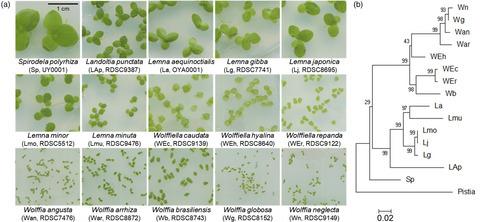Our official English website, www.x-mol.net, welcomes your
feedback! (Note: you will need to create a separate account there.)
Coordination of leaf economics traits within the family of the world's fastest growing plants (Lemnaceae)
Journal of Ecology ( IF 5.3 ) Pub Date : 2021-05-24 , DOI: 10.1111/1365-2745.13710 Hidehiro Ishizawa 1, 2 , Yusuke Onoda 3 , Kaoru Kitajima 3 , Masashi Kuroda 1, 4 , Daisuke Inoue 1 , Michihiko Ike 1
中文翻译:

世界上生长最快的植物(Lemnaceae)家族中叶片经济性状的协调
更新日期:2021-05-24
Journal of Ecology ( IF 5.3 ) Pub Date : 2021-05-24 , DOI: 10.1111/1365-2745.13710 Hidehiro Ishizawa 1, 2 , Yusuke Onoda 3 , Kaoru Kitajima 3 , Masashi Kuroda 1, 4 , Daisuke Inoue 1 , Michihiko Ike 1
Affiliation

|
- The duckweed family (Lemnaceae) is a group of free-floating aquatic plants with bodies consisting of single floating fronds that multiply clonally. Although they are known to have the fastest relative growth rate (RGR) among higher plants, their functional trait coordination in relation to within-family variation of RGR is poorly understood.
- We tested how duckweed species fit within the trait covariation patterns known as the world-wide leaf economics spectrum (LES). To this end, several functional traits were evaluated for 15 duckweed species, and their covariation patterns were compared with those in the global database of plant functional traits.
- As a group, duckweeds exhibited the most acquisitive suite of traits, with extremely small leaf mass per area (LMA), short life span and high mass-based photosynthetic rate (Amass). These LES traits showed a tight correlation with RGR, corroborating our hypothesis that acquisitive leaf resource economics underpins their extremely high RGR. However, unlike other higher plants, LMA showed weak association with leaf life span and Amass within duckweed family. We also found a unique positive correlation between duckweed LMA and area-based photosynthetic rates, an indication that their LMA represents different functional significance compared to typical higher plants.
- Synthesis. Duckweeds, the world's fastest growing plants, mostly follow the world-wide LES and locate at its extreme end. The slight deviation from the LES highlights that duckweeds experience some physical and chemical constraints not faced by other higher plants.
中文翻译:

世界上生长最快的植物(Lemnaceae)家族中叶片经济性状的协调
- 浮萍科(浮萍科)是一组自由漂浮的水生植物,身体由无性繁殖的单个漂浮叶子组成。尽管已知它们在高等植物中具有最快的相对增长率 (RGR),但它们与 RGR 的家族内变异相关的功能性状协调知之甚少。
- 我们测试了浮萍物种如何适应称为全球叶子经济学谱 (LES) 的性状协变模式。为此,对 15 个浮萍物种的几个功能性状进行了评估,并将它们的协变模式与全球植物功能性状数据库中的那些进行了比较。
- 作为一个群体,浮萍表现出最贪婪的性状,单位面积叶质量 (LMA) 极小,寿命短,基于质量的光合速率 ( A mass ) 高。这些 LES 特征显示与 RGR 密切相关,证实了我们的假设,即获得性叶片资源经济学支持其极高的 RGR。然而,与其他高等植物不同,LMA 与浮萍科中的叶寿命和A质量的关联性较弱。我们还发现浮萍 LMA 与基于面积的光合速率之间存在独特的正相关,这表明它们的 LMA 与典型的高等植物相比具有不同的功能意义。
- 合成。浮萍,世界上生长速度最快的植物,大多遵循世界范围内的LES,并位于其最末端。与 LES 的轻微偏差突出表明浮萍经历了一些其他高等植物所没有的物理和化学限制。































 京公网安备 11010802027423号
京公网安备 11010802027423号